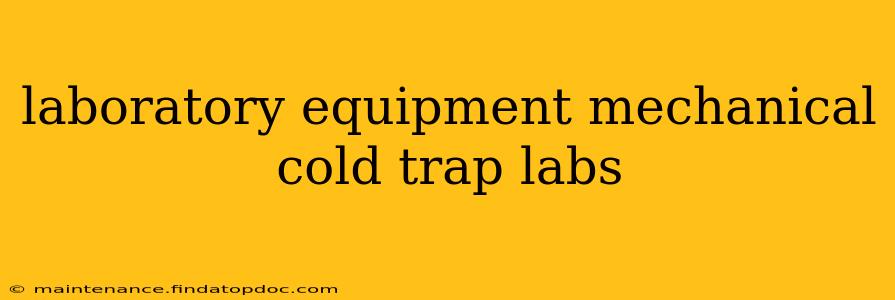Maintaining a clean and efficient laboratory environment is paramount for accurate and reliable results. One crucial piece of equipment often overlooked is the mechanical cold trap. These devices play a vital role in protecting sensitive instruments and ensuring the purity of experiments by preventing unwanted vapors and contaminants from entering vacuum systems. This comprehensive guide explores the world of mechanical cold traps, their applications, and considerations for selecting the right one for your laboratory.
What is a Mechanical Cold Trap?
A mechanical cold trap, also known as a refrigerated cold trap, is a crucial piece of laboratory equipment used in vacuum systems to condense and remove volatile substances. Unlike cryogenic cold traps that rely on liquid nitrogen or other cryogens, mechanical cold traps use a refrigeration system to achieve low temperatures, typically ranging from -40°C to -80°C, depending on the model. This cooling capability allows the trap to condense various vapors, preventing them from reaching and potentially damaging sensitive equipment such as vacuum pumps or affecting the purity of the experiment.
How Does a Mechanical Cold Trap Work?
The principle behind a mechanical cold trap's functionality is simple yet effective. Vacuum systems often generate vapors and condensable materials during processes like distillation, evaporation, or freeze-drying. These vapors travel through the vacuum lines, and if left unchecked, can reach and contaminate sensitive components. The mechanical cold trap is strategically placed within the vacuum line, usually near the vacuum pump. As the vapors pass through the chilled trap, they condense onto the cold surfaces, effectively trapping them and preventing further travel. Regular defrosting or purging is necessary to remove the accumulated condensates.
What are the Applications of Mechanical Cold Traps in Labs?
Mechanical cold traps find applications across various scientific disciplines:
- Vacuum Systems Protection: Preventing corrosive or reactive vapors from reaching and damaging expensive vacuum pumps. This significantly extends the lifespan of these vital instruments.
- Sample Purity: Ensuring the purity of samples by trapping volatile contaminants during processes like lyophilization (freeze-drying) or vacuum distillation.
- Environmental Monitoring: Used in conjunction with environmental chambers to capture and analyze volatile organic compounds.
- Chemical Synthesis: Protecting reaction vessels and preventing cross-contamination in chemical synthesis involving volatile reactants or products.
- Material Science: Used in various material processing techniques under vacuum conditions to prevent contamination of samples.
What are the Different Types of Mechanical Cold Traps?
Several factors differentiate mechanical cold traps, impacting their suitability for specific applications.
- Cooling Capacity: Measured in Watts or BTUs, this determines the volume of vapor the trap can effectively condense. A higher capacity is necessary for applications generating larger volumes of condensates.
- Temperature Range: The minimum temperature achievable influences the type of vapors the trap can handle. Lower temperatures are needed for condensing substances with higher boiling points.
- Capacity: Refers to the trap's volume, indicating the amount of condensates it can hold before requiring defrosting or purging.
- Construction Materials: Materials like stainless steel are common for their chemical resistance and durability. Glass traps provide better visibility, allowing for monitoring of the condensate level.
What are the Advantages and Disadvantages of Mechanical Cold Traps?
Advantages:
- Reduced risk of contamination: Prevents unwanted vapors from reaching sensitive equipment or samples.
- Extended equipment lifespan: Protects vacuum pumps and other valuable instruments.
- Improved experimental reproducibility: Maintains consistent and reliable results by eliminating contaminant interference.
- Ease of use: Many models offer user-friendly operation and maintenance.
- Cost-effective: Less expensive than cryogenic cold traps in the long run.
Disadvantages:
- Limited cooling capacity compared to cryogenic traps: May not be suitable for all applications involving high vapor loads.
- Requires regular defrosting/purging: This adds to the maintenance workload.
- Potential for freezing: If the temperature gets too low, the condensate could freeze and potentially block the trap.
How to Choose the Right Mechanical Cold Trap for Your Lab?
Choosing the appropriate mechanical cold trap involves careful consideration of several factors:
- Application: Identify the specific processes where the trap will be utilized and the types of vapors to be condensed.
- Vacuum System: Ensure the trap's capacity and connections are compatible with your existing vacuum system.
- Cooling capacity: Select a trap with sufficient cooling capacity to handle the expected vapor load.
- Temperature range: Choose a trap capable of reaching sufficiently low temperatures to condense the target vapors.
- Budget: Balance the desired features and performance with the available budget.
What are the Safety Precautions When Using a Mechanical Cold Trap?
- Always follow the manufacturer's instructions for operation and maintenance.
- Wear appropriate personal protective equipment (PPE) when handling the cold trap and condensates.
- Allow the trap to reach room temperature before servicing or cleaning.
- Avoid touching the cold surfaces to prevent frostbite.
- Properly dispose of the collected condensates according to safety regulations.
This comprehensive guide offers a detailed overview of mechanical cold traps for laboratories. Remember, understanding the specifics of your application and considering the factors outlined above will ensure that you select the most appropriate and efficient cold trap for your laboratory needs.
